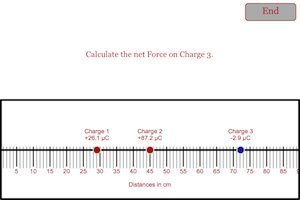
|
Make sure you know how to find the net force on one of the charges in a line of charges. |
|
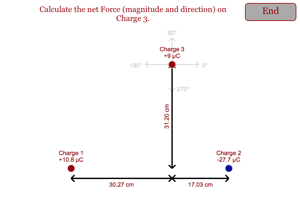
|
Make sure you can find the net force on one of the charges in a triangular arrangement of charges. |
|
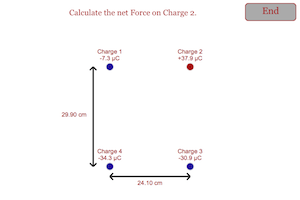
|
Make sure you can find the net force on one of the charges in a rectangular arrangement of charges. |
|
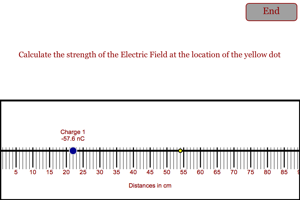
|
Determine the electric field at a point in the vicinity of a charge. |
|
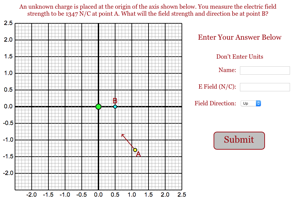
|
Determine the electric field at point B when when you know the electric field at point A. |
|
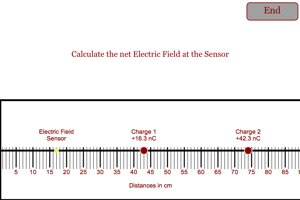
|
Determine the electric field at point on a line based on the values and location of two charges. |
|
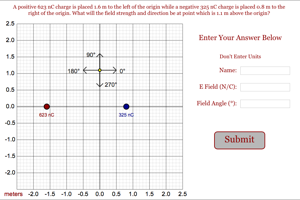
|
Determine the net electric field strength and direction that is caused by two different charges. |
|
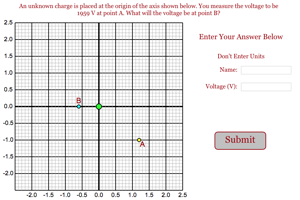
|
Determine the voltage at point B when when you know the voltage at point A. |
|
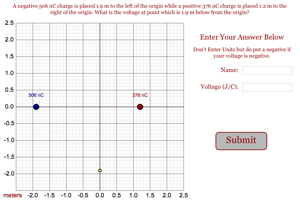
|
Determine the net voltage from two charges. |
|
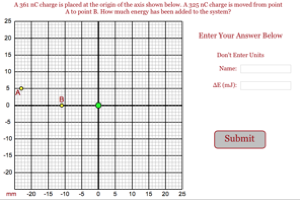
|
Determine the energy that must be added to a system to move a charge from one location to another in the vicinity of another charge. |
|
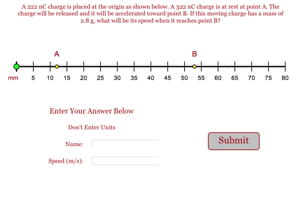
|
Determine the speed of a particle that has been repelled away from another particle with the same type of charge. |
|
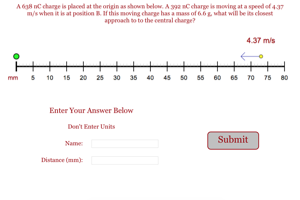
|
In this problem you will be asked to find the closest approach between two charges. The charge at the origin is held at rest. The other charge is moving toward the charge with a certain speed and your job is to figure out how close the two charges will get before the moving charge stops and then begins moving in the opposite direction. |
|
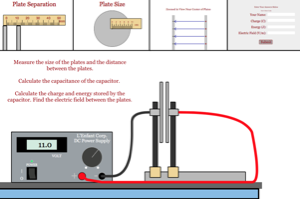
|
In this problem you will be asked to determine the charge and energy stored on a capacitor. You will also find the electric field between the plates of the capacitor. |
|
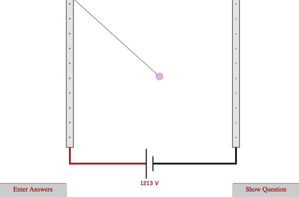
|
Students must determine the charge on a pith ball that is suspended in an electric field. |
|
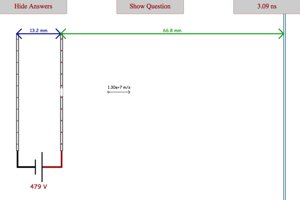
|
Students must determine the time it takes an electron to reach a phosphorescent screen when it is fired by a capacitor. Students must also find the top speed of the electron. |
|
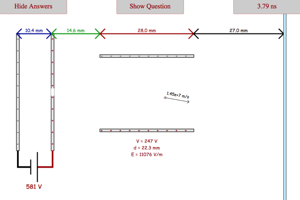
|
Students must determine the time it takes an electron to reach a phosphorescent screen when it is fired by a capacitor. Students must also find the top speed of the electron and the amount of vertical deflection it experiences. |
|
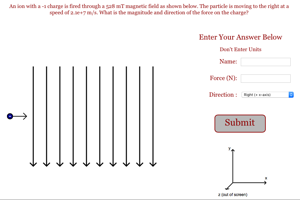
|
In this problem you will be asked to find the force and the direction of the force on a charged particle moving through a magnetic field. |
|
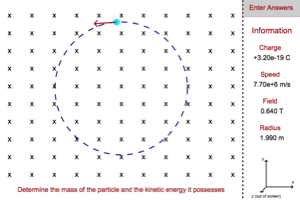
|
In this problem you will be asked to determine the mass and KE of a particle trapped in a magnetic field. You will be given the charge of the particle as well as the speed and strength of the field. |
|
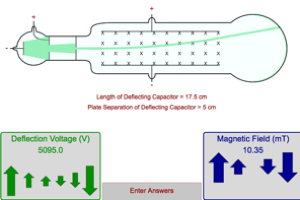
|
In this problem you will be asked to determine the mass and speed of a particle being fired through variable magnetic and electric fields. This problem is done after students determine the charge of an electron using the Millikan Oil Drop Experiment. |
|
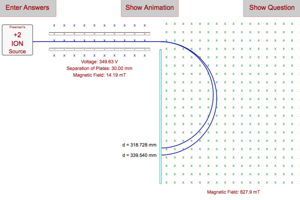
|
In this problem you will be asked to determine the mass of two different isotopes of an element based on their deflection by a magnetic field. |
|
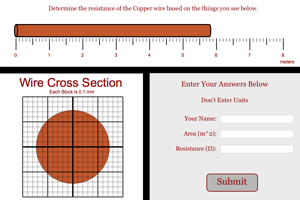
|
In this program you will need to determine the resistance of a wire based on its composition and its physical dimensions. You will be asked to give the area of the wire in square meters and the resistance of the wire in Ohms. |
|
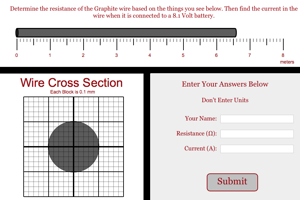
|
In this program you will need to determine the resistance of a wire based on its composition and its physical dimensions. You will be asked to find the current that would flow through the wire when the wire is connected to a certain voltage. |
|
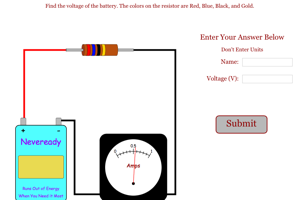
|
Determine the voltage of the battery based on the colors of the resistor and the current in the circuit. |
|
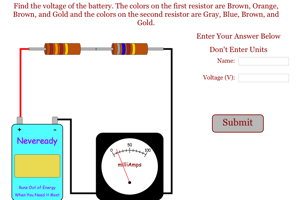
|
Determine the voltage of the battery based on the colors of the resistors and the current in the series circuit. |
|
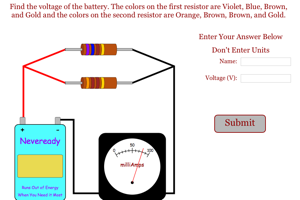
|
Determine the voltage of the battery based on the colors of the resistors and the current in the parallel circuit. |
|
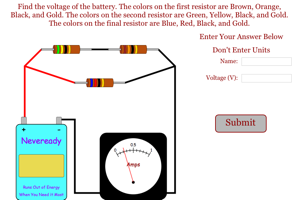
|
Determine the voltage of the battery based on the colors of the resistors and the current in a combination circuit. |
|
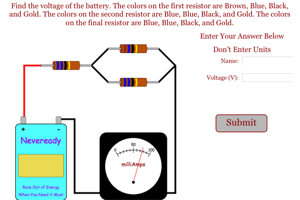
|
Determine the voltage of the battery based on the colors of the resistors and the current in a combination circuit. |
|
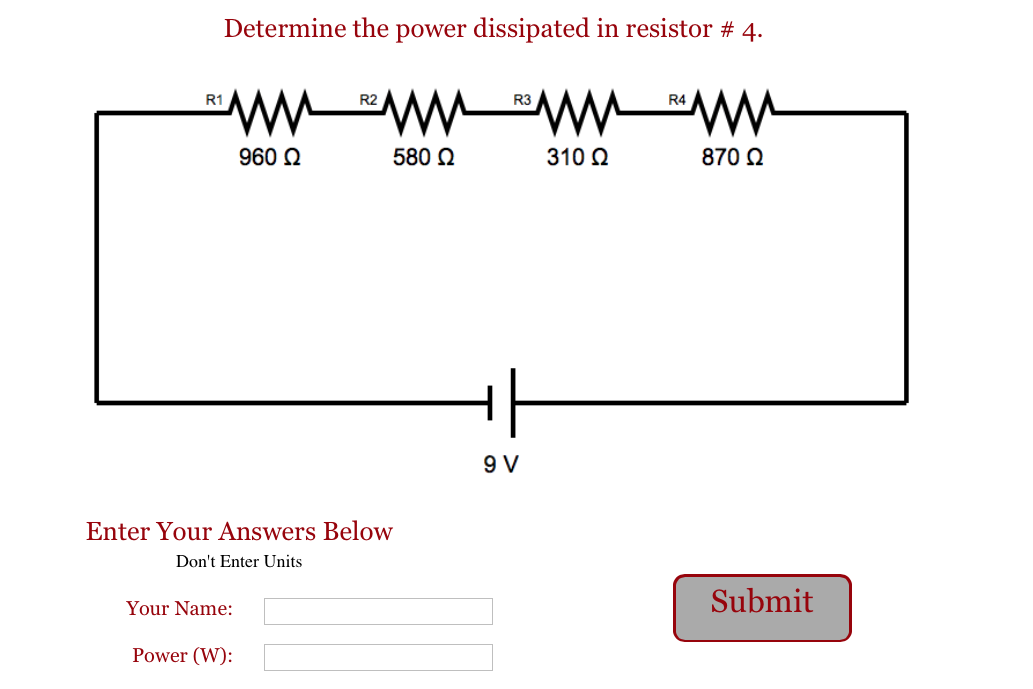
|
Make sure you can determine the amount of power dissipated in a resistor that is part of a series circuit. |
|
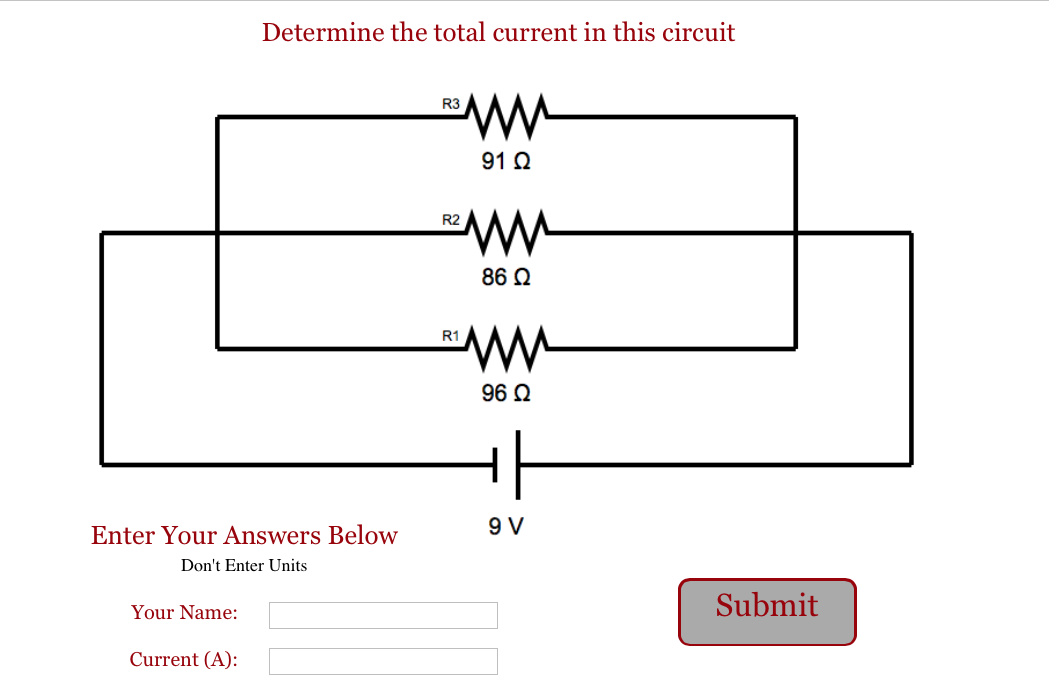
|
Make sure you can determine the amount of current that is present in a parallel circuit. |
|
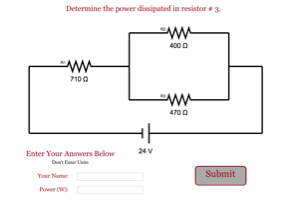
|
Make sure you can determine the amount of power dissipated in a resistor in a complex circuit. |
|
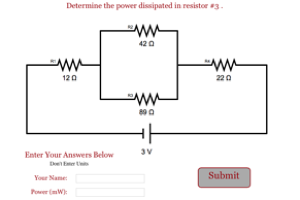
|
Determine the amount of power dissipated in a resistor in a complex circuit. |
|
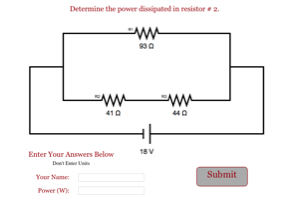
|
Make sure you can determine the amount of power dissipated in a resistor in a complex circuit. |
|
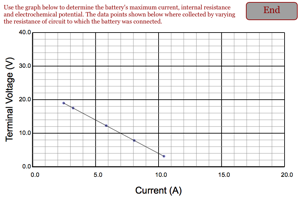
|
Determine the internal resistance of a battery based on the graph of terminal voltage vs. current. You must also find the maximum current and the electrochemical potential. |
|
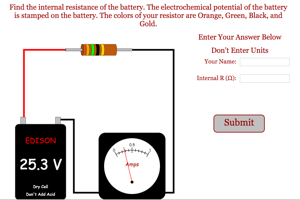
|
Determine the internal resistance of a battery based on the electrochemical potential and the current that comes out of the battery when it is hooked to a resistor. |
|
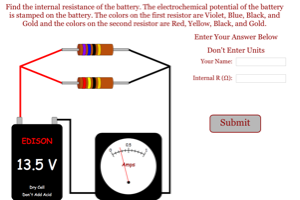
|
Determine the internal resistance of a battery based on the electrochemical potential and the current that comes out of the battery when it is hooked to a series of resistors connected in parallel. |
|
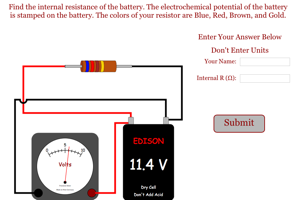
|
Determine the internal resistance of a battery based on the electrochemical potential and the voltage that is measured at the terminals of the battery when it is being used. |
|
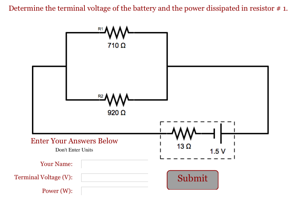
|
This program will ask the students to find the terminal voltage of a battery with significant internal resistance. Students will also be asked to get the power of one of the external components for the circuit. |
|
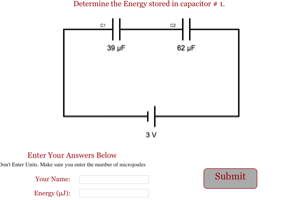
|
Determine the amount of energy stored on a capacitor in a series circuit. |
|
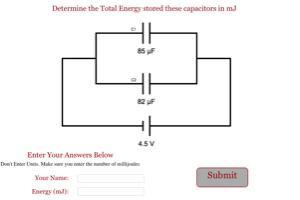
|
Determine the total energy stored on a group of capacitor in a parallel circuit. |
|
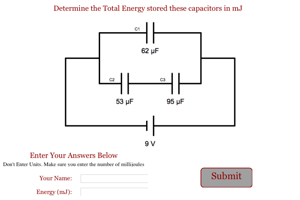
|
Determine the total energy stored on a group of capacitor in a combination circuit. |
|
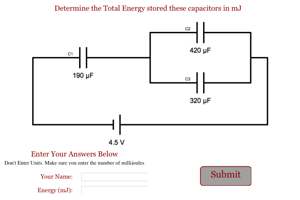
|
Determine the total energy stored on a group of capacitor in a combination circuit. |
|
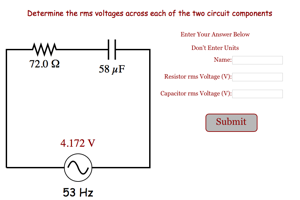
|
Determine the initial current and final energy in an RC circuit powered by a DC source. |
|
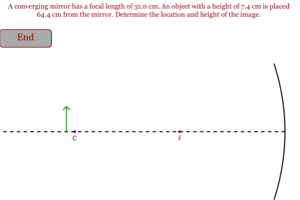
|
Determine the height and location of the image formed by a converging mirror. |
|
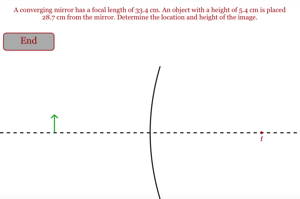
|
Determine the height and location of the image formed by a diverging mirror. |
|
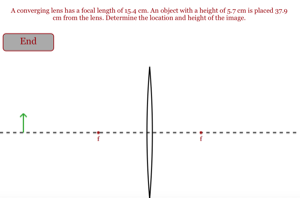
|
Determine the height and location of the image formed by a converging lens. |
|
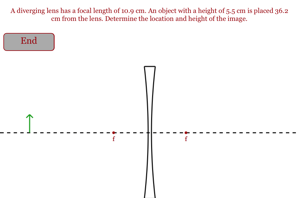
|
Determine the height and location of the image formed by a diverging lens. |
|
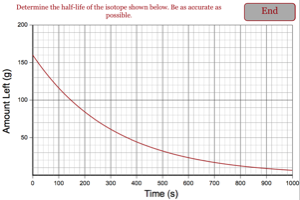
|
In this problem you must determine the half-life of an isotope based on the graph of the amount of the isotope left as a function of time. |
|
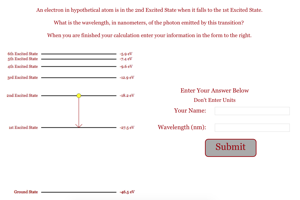
|
In this problem you must determine the wavelength, in nanometers, of light emitted from an atom. |
|
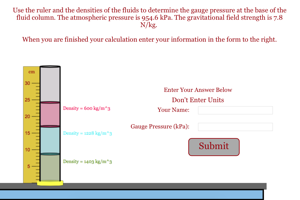
|
Students must determine the fluid pressure caused by a column of three immiscible fluids. |
|
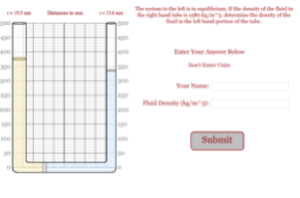
|
Students must determine the density of a fluid based on the fluid levels in a u-tube. |
|
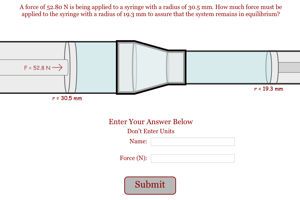
|
Students must determine the force required to hold a syringe in place when a second force is trying to get it to move. |
|
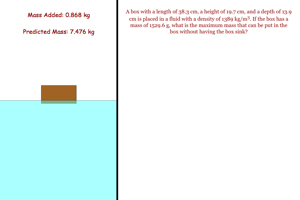
|
Students must figure out how much mass can be put in a boat without having the boat go fully under the fluid. |
|
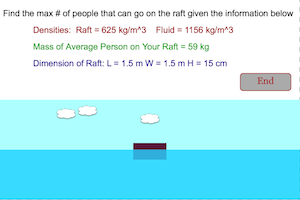
|
Students must figure out the number of people that can go on a raft without having the raft go fully under the fluid. |
|
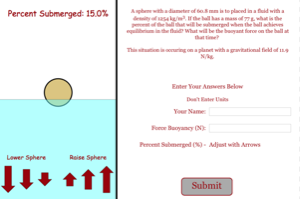
|
Students must figure out how much of a ball will be under a fluid when it is in equilibrium with its environment. |
|
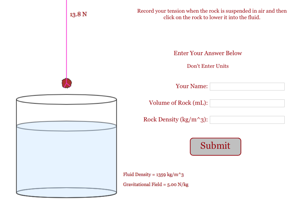
|
Students must determine the density of a rock based on the change in tension in the supporting string when the rock is lowered into a fluid. |
|
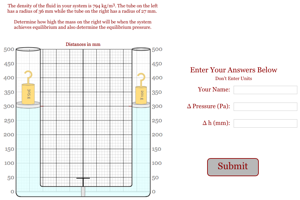
|
Students must determine the difference in pressure that leads to the motion of masses in an hydraulic lift and the difference in height when the piston reaches equilibrium. |
|
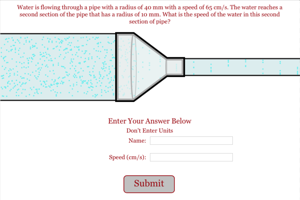
|
In this problem you will have water flowing through two sections of piping with different diameter pipes joined by a coupler. You will be given the speed of the water in the first section of piping and you will need to find the speed in the second section. |
|
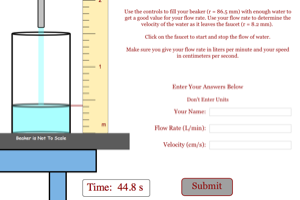
|
Students must determine the flow rate and speed of the water leaving a faucet based on the time it takes to fill a beaker to a certain height and the radius of the faucet the water is exiting from. |
|
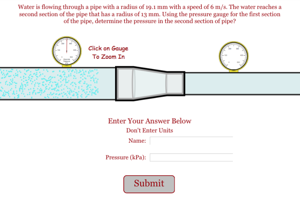
|
In this problem you will have water flowing through two sections of piping with different diameter pipes joined by a coupler. The pressure gauge on one of the two pipes is broken. Your task is to find the pressure in the section of the pipe with the broken gauge. |
|
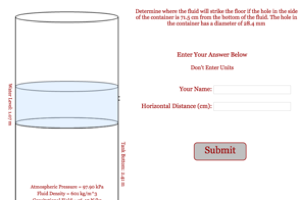
|
In this problem you will have a tank of fluid get punctured and you will need to find the landing location of the fluid. |
|
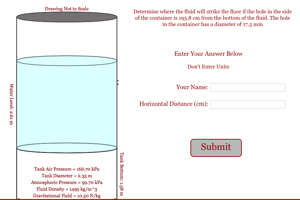
|
In this problem you will have a tank of fluid get punctured and you will need to find the landing location of the fluid. The tank in which the fluid is housed is pressurized above the value of the atmospheric pressure. |
|
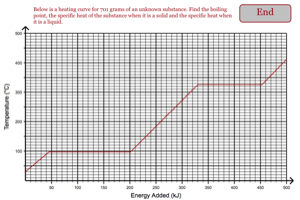
|
Students must read a heating curve to determine what an object's boiling point is as well as its specific heat. |
|
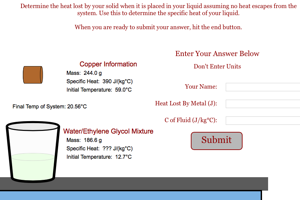
|
This program asks students to determine the specific heat of a fluid based on the amount of temperature change that occurs when a hot object is placed in the fluid. |
|
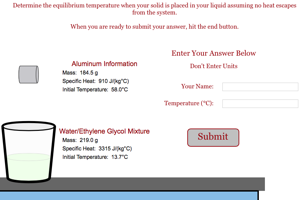
|
Students must figure out the final temperature of a system when a hot object and a cold object are placed in a closed container. |
|
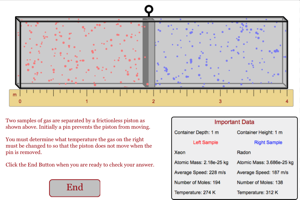
|
Determine the temperature required to keep a piston in equilibrium. |
|
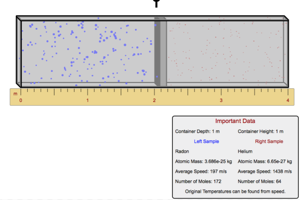
|
Determine the temperature required to keep a piston in equilibrium. You must use information about the speed of the atoms in the left hand chamber to help you find the equilibrium pressure. |
|
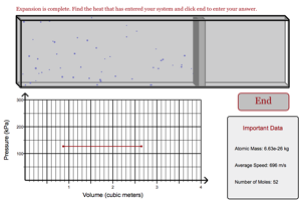
|
Determine the heat that has been added to a gas in an isobaric process. |
|
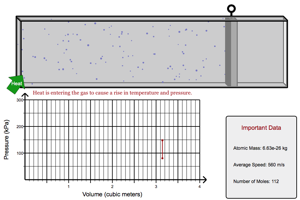
|
Determine the heat that has been added to a gas in a process where the volume does not change. |
|
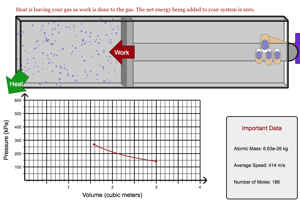
|
Determine the internal energy in a sample of gas that goes through an isothermal compression. |
|
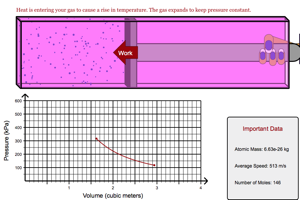
|
Determine the work that was done when no heat enters or leaves the system. |
|
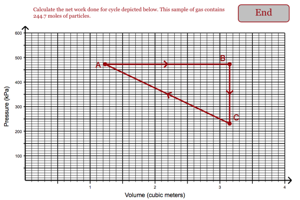
|
Determine the net work that is done when a gas is brought through a simple three step process. Data is obtained from a PV Diagram. |
|
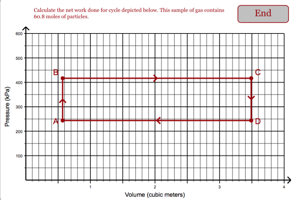
|
Determine the net work that is done when a gas is brought through a simple process. Data is obtained from a PV Diagram. |
|
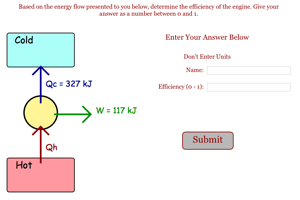
|
Determine the efficiency of an engine (0 - 1) based on the energy flow that is presented to you. |
|
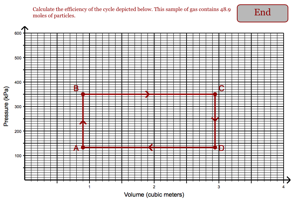
|
Determine the efficiency of an engine (0 - 1) based on the PV Diagram that is presented to you. |
|
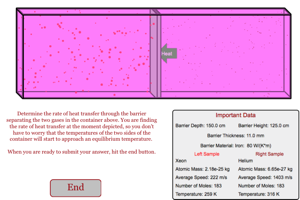
|
Determine the rate at which heat moves through a barrier that is separating gases at two different temperatures. |
|
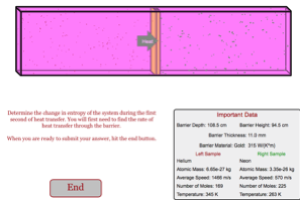
|
Determine the change in entropy that occurs when heat moves through a barrier that is separating gases at two different temperatures. |
|
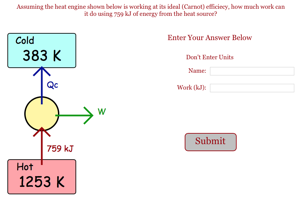
|
Determine the work done by an engine working at it ideal (Carnot) efficiency. |
|